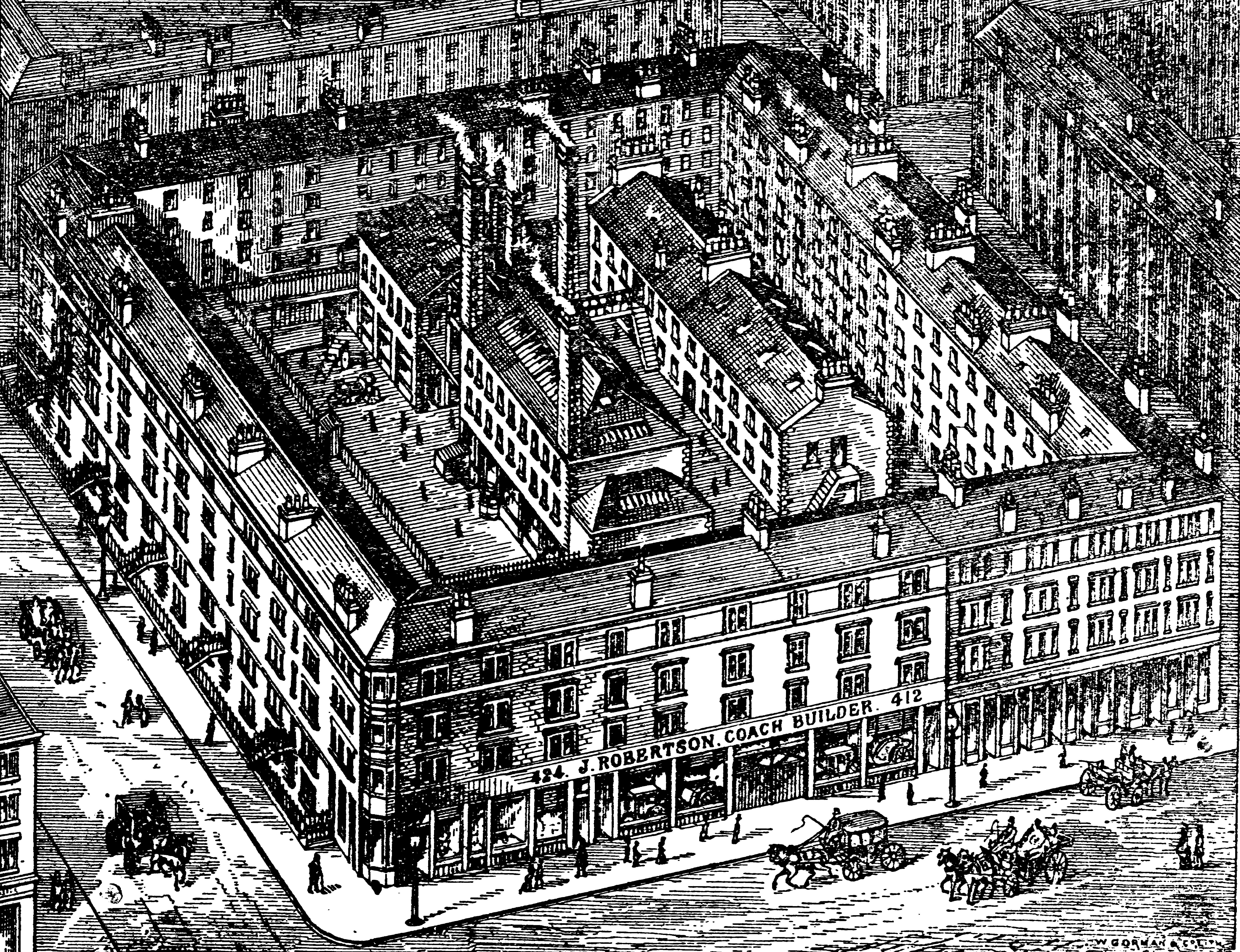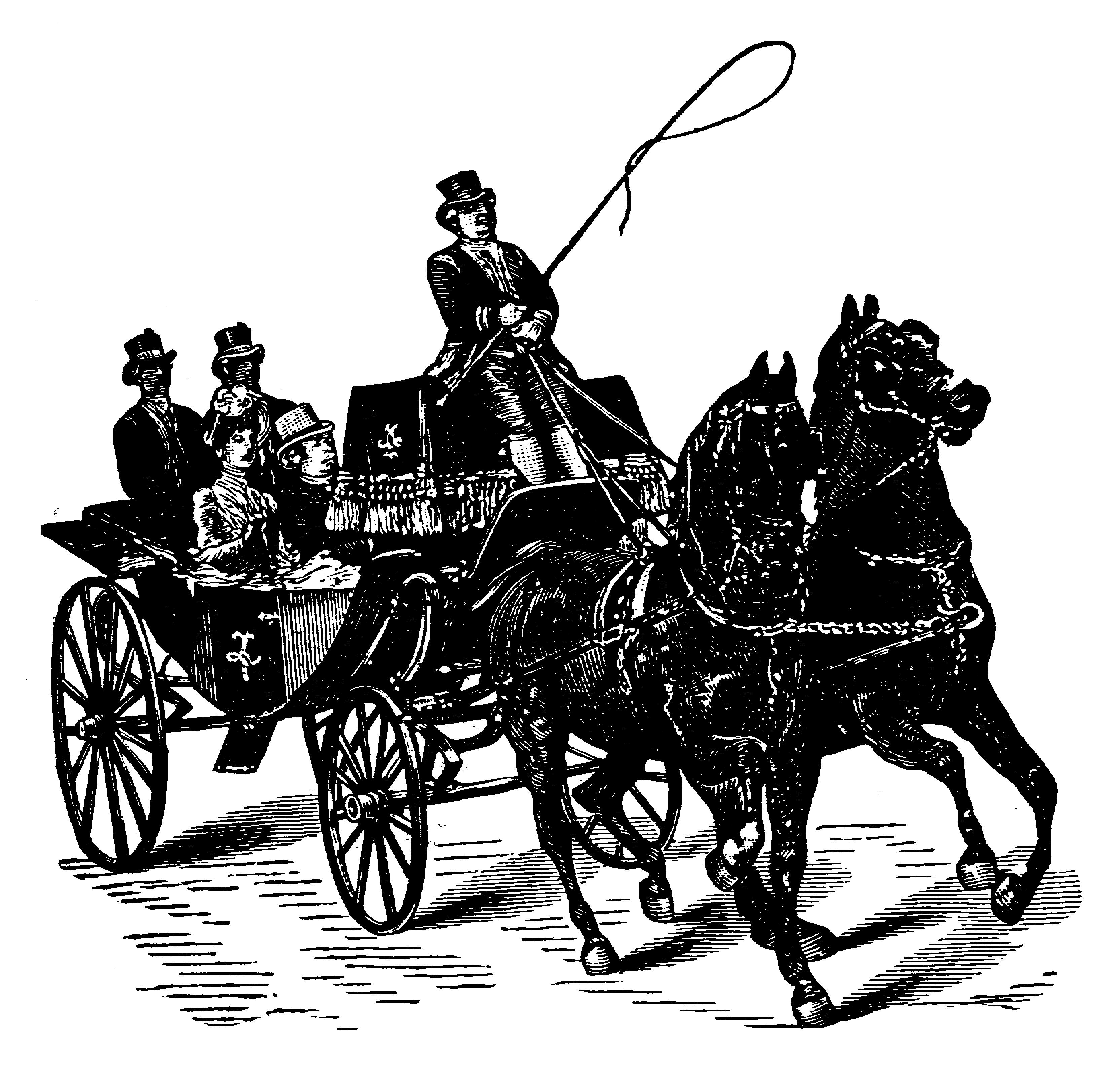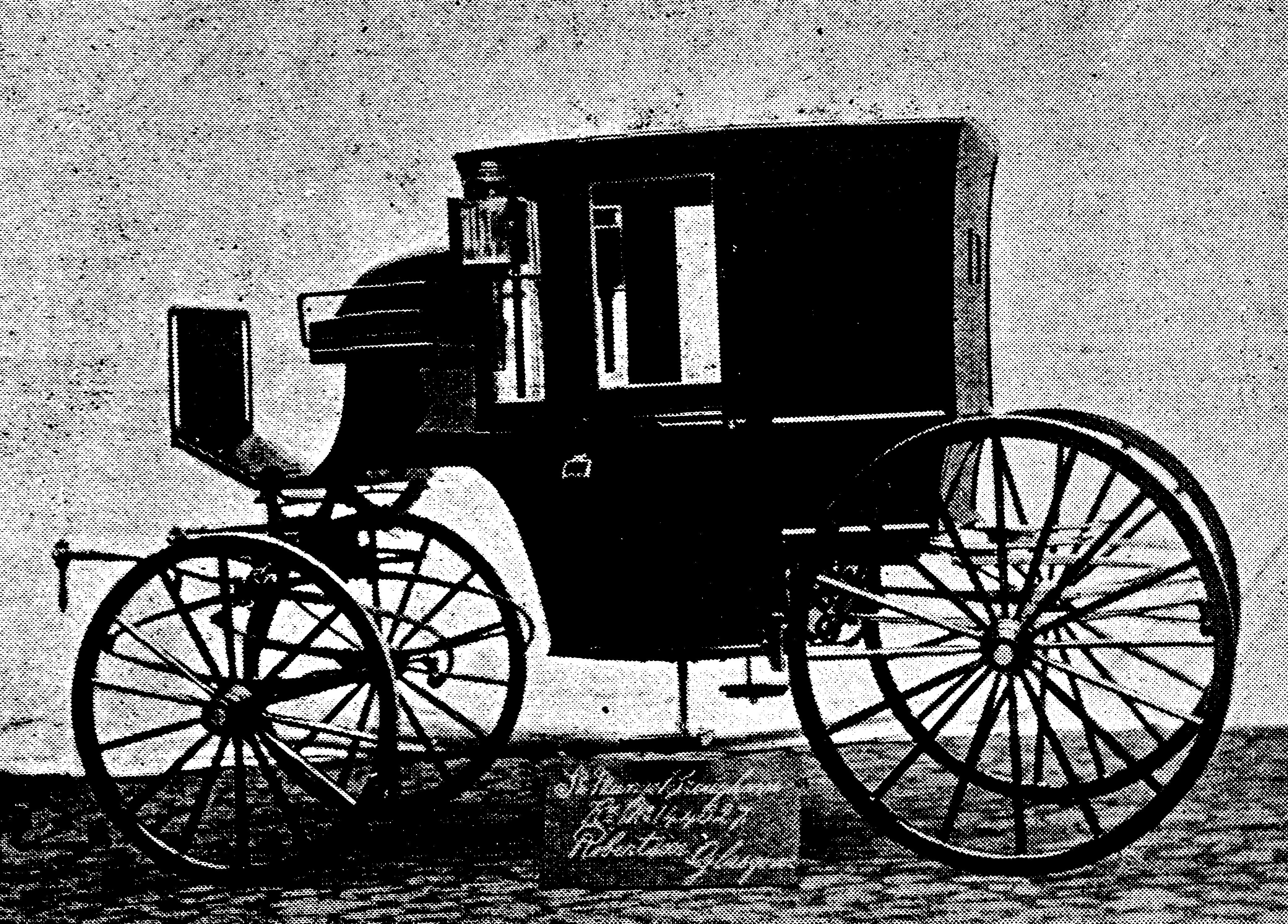
John Robertson
MR. JOHN ROBERTSON'S Coachbuilding Works, St. Vincent Street, Glasgow.
There is no industry in which the harmonious combination of the mechanical and applied arts is more effectively exemplified than in carriage building. From the heavy, lumbersome, and uncomfortable equipages of the olden time have been evolved a variety of modern vehicles which, as constructed by the best makers, are marvels of elegance, lightness, and comfort. Some carriages, indeed, are fitted up with every appointment of luxury and convenience which ingenuity, taste, and skill can devise. So exacting are the requirements of carriage-building now-a-days, that those who aspire to engage in the business have to undergo an arduous technical training. This, however, does not suffice to ensure success, unless with it be conjoined enterprise, intelligence, and assiduity for competition is keen, and it is necessary to keep pace with the times.
These qualities are possessed in a remarkable degree by Mr. John Robertson, of Glasgow, founder of a firm which has gained a wide reputation for the excellence of its work and the numerous improvements in carriage-building it has introduced. At the present moment, there is no one engaged in the trade who is more respected or held in higher esteem than Mr. John Robertson. The very extensive business now carried on by his firm has been gradually reared on a modest foundation. Thirty-four years ago, Mr. Robertson began in what, looking back, he must regard as a small way, in Bothwell Street, Glasgow. His skill and conscientiousness were speedily rewarded. The volume of trade grew steadily, till at last he realised that the premises he occupied were inadequate to cope with it. He therefore removed to St. Vincent Street, where he set up a commodious factory. His business continuing to develop, he found it necessary from time to time to enlarge his premises, till he acquired the spacious and model establishment where the business of the firm is now carried on. That establishment comprises the range of buildings extending from No. 412 to 424, St. Vincent Street. The premises have a ground area of 4,250 superficial feet, and the frontage, which abuts on one of the principal thoroughfares of the City, is an imposing one. The works are entered from Dorset Street. The interior of the establishment is as interesting as its exterior is imposing. The various departments are in themselves distinct, yet each is the necessary complement of the other, and they are arranged on the most approved principles. They are provided with every possible contrivance for facilitating the work and obviating defects during the different stages of it. Whether as regards utility or general effect, therefore, they far surpass expectation.

Entering from St. Vincent Street, we find that the premises consist of a ground floor and three upper storeys. It is on the ground floor that the showrooms proper are situated. In this spacious warehouse some unique examples of the carriage builders art may be inspected, and the magnitude of the collection may well excite the surprise of the visitor. Like the typical race-horse, the vehicles manufactured by this firm are full of points. Design, equipment, and finish are all seemingly perfect, but the persistent endeavour of the firm has been to beat perfection and to eclipse their own previous achievements.
In addition to the exhibition rooms, there are, on the ground floor, rooms in which are stored various materials used in the manufacture of modern vehicles. In one, there is a valuable collection of wheels mainly American, for Mr. Robertson is a large importer of these and of wheel timbers. As a carriage builder with a high reputation to sustain, Mr. Robertson is particular, even to fastidiousness, respecting the quality of the wheels supplied to him, and it was not till he had tested those of most leading American makers that he convinced himself of the general superiority of the wheels manufactured by Messrs. Hoopes Brothers and Darlington. Speaking of wheels, it may be mentioned that Mr. Robertson has devised a system whereby, in wheels made with bent rims, unsightly felloe plates may be dispensed with. His is a system of double dowelling or dovetailing - that is to say, with double tongues and mortice holes. The upper mortice is smaller than the lower one, the technical explanation being that as the upper part of the rim is supported by the tyre, the lower part therefore requires the greater strength. Another store room is filled with spokes, felloes, tyres, and sectional requisites of various kinds. Storage accommodation is likewise provided for a still more miscellaneous collection of accessories, ranging from nails to costly velvets and sumptuous upholstery materials.
Before referring to the work rooms, with which the three upper floors are mainly occupied, it may be mentioned that, at the factory entrance, there is a storage place for rough timber, including such ornamental woods as ash, mahogany, and pine. Of these there is a very large stock. It is the rule of the establishment to classify the timber according to the date of its delivery, so that the degree of maturity it has attained is thus indicated. Proper seasoning of the wood is, in carriage building, a matter of vital importance, and, to ensure that desideratum, the best methods are here adopted. The timber is kept dry under cover, but the place where it is stored is thoroughly permeated by currents of air. The numerous upstairs rooms are distinguished as sectional workshops. There is, for example, the body shop, the fitters shop, the finishing shop, the paint shop, the varnishing shop, the blacksmiths shop, and so forth. The fact that constant employment is provided in the establishment for between seventy and a hundred hands will convey some idea of the magnitude of the business. All the rooms mentioned are admirably adapted for the particular class of work carried on in each, and are well provided with mechanical contrivances such as lifts and trollies.
Mr. John Robertson, who is a vice-president of the Institute of British Carriage Manufacturers (Incorporated), gave an interesting description, at the meeting of that body in Glasgow, three years ago, of his painting and varnishing rooms. That description was contained in a paper on coach varnishing read by him a paper which, as setting forth the writers practical experiences, was deemed by the members of the Institute a most valuable contribution. To technical readers, it is likely to be exceedingly interesting ; and, as regards the varnishing room in particular, merits quotation. My main painting loft, he said, which is on the top floor of a three-storey building, is 70 feet from north to south by 36 feet from east to west. The varnishing room is at the south end of this, divided from it by a glass partition. Its length is the same as the width of the painting loft, namely, 36 feet ; and its width 18 feet ; with light on all sides and a borrowed light from the roof. It is heated by two rows of hot-water pipes on the east, west, and south sides. Please observe that, in the varnishing room, the joists which support the floor run lengthways ; and, in order to get fresh air introduced, I have the walls of this room pierced on the outside, immediately below the flooring and between the joists, with openings, east and west, 18 by 15 inches in size. These openings are never closed from the outside, the air travelling, from either side, the whole length of the room, where it is let into the inside by openings in the floor.
This extract, apart from its descriptive serviceableness, suggests how painstaking is the attention Mr. John Robertson bestows upon the details of his business. That unconscious self-revelation affords a clue to the secret of his success. He is always contriving how some improvement may be effected here, some novelty introduced there, or how the methods of production may be rendered more invariably accurate. This faculty, added to his vigorous energy, his absorption in the business he is justly proud of having founded, his unwearied application, his quickness to perceive the effectiveness of new developments and modifications, and his personal integrity are the factors which have contributed to his pre-eminence as a carriage builder. None are readier to recognise his good qualities and his business acumen than his trade congeners. Already it has been mentioned that he is a vice-president of the Institute of British Carriage Manufacturers. It may further be cited, as an evidence of the appreciation in which he is held, that the National Scottish Association for the Repeal of the Carriage Tax did him the honour of appointing him chairman. No higher compliment could be paid him by his fellows. In respect of zeal, energy, and capacity, he is ably seconded by his brother and partner, Mr. James Robertson, who is a thoroughly practical man and one who, as identified with social and religious movements, is well known locally.
Something has been said of Mr. John Robertsons practical ingenuity and of an improved pattern of wheel he has devised. Not only, however, is he an intelligent and enterprising adaptor who, as such, has gained no inconsiderable celebrity, but he is also a very successful and noted inventor. He holds patents for various contrivances, the merits of which have been conceded by other manufacturers. He is, for example, the inventor of a new cee and elliptic spring for wheeled vehicles, the superiority of which over anything of the kind previously in use remarkable as was the pitch of perfection to which carriage springs have been brought is everywhere acknowledged. Although his firm turns out the highest class vehicles of every recognised pattern, there are certain specialities with which the name of Mr. John Robertson is worthily identified. Amongst, others, there are the Aesthetic and Medium Aesthetic Brougham, the Royal Dane Victoria and Gondola Square Landau. This last was patented in July, 1885. All of these are marvels of symmetry, utility, and durability. The latest designs and specialised novelties produced by the firm include the New Queen Anne or St. Mungo Brougham. If Lord Brougham, who was so enamoured of the original vehicle, which bears his name and which was built in accordance with his own instructions, could revisit the glimpses of mundane life, he would be greatly astonished by the exquisite finish of the conveyance which has now been evolved by Mr. John Robertson from his glorified street cab.

In the firms illustrated pattern books, which are thoroughly trustworthy, Mr. John Robertson places his long experience and practical skill at the disposal of his patrons. What he has to say, for instance, about the use of steel in carriage building, is noteworthy. After carefully testing steel, he says he recommends it for tyres of wheels, and for several years he has used it on new carriages with great advantage. Now that former defects in the welding of steel have been overcome, he is prepared to supply carriages mounted with steel forgings and steel axles. As regards axletrees, he has found, where freedom from noise and vibration are important, that after trying the American India rubber cushioned Bush, also the French rubber cushioned axletree, the noiseless Carmont patent rubber tyre is the best. We also learn that, wherever the rocker to the front board can be dispensed with, this is done, with the result that a two-fold advantage is gained : increased lightness in appearance and a saving of labour.

As an exhibitor, Mr. John Robertson has, for the last quarter of a century, been uniformly successful. And not merely has he been successful in gaining awards, but he has invariably carried off premier honours. This is remarkable, considering that he has never been backward in exhibiting, but has, on the contrary, sent vehicles of his manufacture to the leading and local agricultural shows up and down the country. In the face of more formidable competition than is likely to be encountered even at the leading agricultural shows, his pre-eminence has never been successfully assailed. At the 1886 Edinburgh International Exhibition, for instance, where competition from all comers was challenged, the superiority of his carriages was so palpable that the gold medal for best style and finish was awarded him. This is an achievement which a manufacturer may well be proud of, even if, like Mr. John Robertson, the novelty of success has worn off possessor as he is of six first-class medals, and never a second class one among them to interrupt the sequence. As yet, his is an unbeaten record, and, as he is not the man to let himself be outstripped in the competitive race if he can help it, he will probably continue to retain the unique position he now occupies.
Back to Index of Firms (1891)